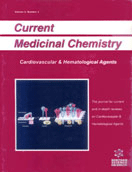Abstract
The renin-angiotensin system is a key target for drugs combating cardiovascular disease. Angiotensinconverting enzyme (ACE) inhibitors and angiotensin receptor type-1 (AT1 receptor) blockers are well known. However, angiotensin peptides can be generated through a number of pathways besides the classic system. This review outlines some of these pathways, their relation to the classic system and the likely effect of inhibiting them. Renin is still the key enzyme in angiotensin peptide generation and seems to be the only route to angiotensin I formation in vivo. Renin inhibitors may have some advantages in terms of specificity. Also, by blocking angiotensin I generation, the production of downstream bioactive angiotensin I metabolites should also be blocked. Chymase, a mast cell serine protease, cleaves angiotensin I to produce angiotensin II and may be important at sites of inflammation such as atherosclerotic plaque. Angiotensin-converting enzyme 2 (ACE2), a carboxypeptidase structurally related to ACE but resistant to ACE inhibitors, has a protective effect on cardiac function. Neutral endopeptidase 24.11 breaks down both atrial natriuretic peptide and angiotensin II. Inhibiting it potentiates the action of endogenous atrial peptide but only affects circulating angiotensin II when basal levels are above normal. Dual inhibitors of ACE and endopeptidase 24.11 may be of value where there is both sodium retention and increased angiotensin II. Targeting the renin-angiotensin system by gene therapy or antibody treatment may provide a longer-term treatment for hypertension.
Keywords: renin-angiotensin system, chymase, ace2, neutral endopeptidase, prorenin
 18
18













